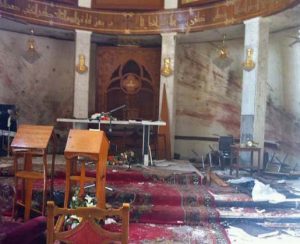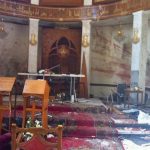(Morning Star News) – Men running, women pleading for God’s mercy, children screaming out of fear, older women trapped under rubble and thick dust rising in the air. This has been a recurring scene in Iraqi cities for close to a decade.
Since June 26, 2004, Assyrian (also known as Chaldean and Syriac) churches have come under attack more than 80 times. The most widely publicized assault came on Oct. 31, 2010, when Islamic terrorists wearing suicide vests invaded Our Lady of Salvation Syriac Catholic Church in Baghdad during mass, shot two priests and then blew themselves up. When it was over, 62 people were killed and 78 injured.
For many people in the United States, news of this attack was their first exposure to the Assyrian people, whose history dates back to 4750 B.C. in Mesopotamia. According to Biblical tradition, they are the direct descendants of Shem, the Son of Noah. The Assyrians, whose language evolved from Akkadian to Aramaic, built the first cities and invented agriculture; river-fed irrigation systems and establishment of the first library were among many other Assyrian inventions that have shaped our world history.
Ancient Assyria, with Nineveh (today’s Mosul) as its capital city, was once a feared kingdom from western Persia into eastern Egypt. Since the fall of Nineveh in 612 B.C. to this day, however, Assyrians have faced repeated ethno-religious cleansing in the Middle East.
Having come to Christ through the disciples Thomas, Thaddeus and Bartholomew in the first century A.D., Assyrians realized a new enemy was on the horizon as Islam spread throughout the region after 622 A.D. The first Islamic attack was perpetrated against them in 650 A.D., when many monks were killed along the Byzantine border. The Assyrians have since suffered attacks on a regular basis, generation after generation. After Ottoman Turkey’s systematic killing of 750,000 Assyrians, 1.5 million Armenians and over 500,000 Greeks in the early 20th century, many Assyrians ended up in refugee camps.
Since the ouster of Iraqi President Saddam Hussein, Iraqi-Assyrian Christians have endured vicious criminal acts by Islamist extremists. Systematic ethno-religious cleansing in Iraq began in 2003, when Christian families received threatening letters offering three options: convert to Islam, pay the jizya (a form of protection tax paid by non-Muslims) or leave their homes, empty-handed.
As families started to receive the letters, terrorists began systematically abducting and killing Christian clergy. To date, there have been hundreds of Christians who have been kidnapped and murdered because of their Assyrian ethnicity and their Christian faith. These acts have driven approximately 1 million people out of their homeland, where their ancestors had lived for thousands of years.
After these atrocities, the Assyrian nation once again finds itself in refugee camps in such countries as Jordan, Turkey, and Syria, waiting their turn to receive entry visas into Western countries. Approximately 450,000 Assyrians have remained in their homeland, preserving the Aramaic language and centuries-old traditions. With Islamist rebels poised to take control of Syria, many Iraqi Christians who took refuge in that country are returning to Iraq, where they face more violence.
As Christians have faced such calamities in Muslim-majority countries throughout the Middle East, the Christian West has remained silent.
Mainstream news media have largely ignored the plight of Iraqi Christians. Part of the reason is that the victims are Christians and do not fit the template of Muslim and Arab victimhood. If such acts of violence had been directed at Muslims, activists in the West would rush to raise awareness and condemn the perpetrators, as they did for the Muslim victims of genocide in Darfur. If any news has been reported about Iraqi Christians, it has come about mainly because of pressure from activists who flooded editors’ desks with news clips and press releases.
How is it that the Christian world has forgotten what the Blessed Pope John Paul II called the Right Lung of the Church? How can church leaders recite the verses from St. Paul in 1 Cor. 12:12 (“As a body is one though it has many parts, and all the parts of the body, though many, are one body, so also Christ”) without cringing with guilt? How can they read verse 26 (“If [one] part suffers, all the parts suffer with it; if one part is honored, all the parts share its joy,”) without weeping in shame?
How can Christians declare themselves followers of Christ when they forget about the church in regions where the body of Christ is being re-crucified? When the dust settles after a church is bombed, and when camera lights are turned off after an interview with the family of a kidnapped Christian, who is it that continues to care about those who are left behind?
The sad truth is that the aftermath in most cases is much harder to endure than the attack itself. Those who have survived are forced to live with the pain and the trauma for the rest of their days. Many survivors had thought their Christian brothers and sister living in the West would rush to their aid, but that help, in most cases, never came. Only silence.
For those who do not believe in the spirit of organized religion and may not want to lend a helping hand because this is happening to “Christians” who may have “deserved it” for keeping their faith, shouldn’t they be outraged at this human rights tragedy? The Assyrians, Copts, Algerians and Sudanese who choose to practice Christianity are humans and deserve the attention that other groups receive when their rights to exist are violated.
This is an age of terrible uncertainty for a people that has existed for over 6,700 years and is now on the verge of extinction.
In the aftermath of the Holocaust in Europe, the great cry was “Never again!” If the world does nothing for the Assyrians, maybe we should amend this slogan to read, “Who’ Next?”
Juliana Taimoorazy is president of the Iraqi Christian Relief Council.
- Damage to Our Lady of Salvation Syriac Catholic Church, after Oct. 31, 2010 attack in Baghdad. (Ankawa.com photo)



The Assyrians where promised an aunotomous region, when they helped the allies defeat the Ottamans, but the British betrayed them back in 1933In the first century they were among the first people to embrace Christianity. Due to the numerous atrocities which befell them over the following centuries because of their religion and nationality, the Assyrians almost lost their identity as a nation. It was not until the middle of the 19th century, when Assyrians came in direct contact with the western world, that their existence attracted the attention of the outside world.At this time the Assyrians were experiencing a cultural renaissance, and played an instrumental role in building modern schools, colleges and technical institutions in Iran, Iraq and other parts of the Middle East during the 19th and 20th centuries. Caught between the two warring parties of WWI, Assyrians suffered most destructive blows because of their religion and ethnicity.First, they fell victim to the wholesale massacre inflicted upon Christians (Assyrians and Armenians alike) under the Ottoman Empire. Hundreds of thousands of Assyrians living as a semi-independent people under their religious and secular head, Patriarch Mar Shimon, in the Itakkari mountains in the southeastern part of Turkey, were driven out of their homeland and forced to join their brethern in the Urmia and Salamas districts in Iran. Then, they were encouraged to join the Allied Forces (British and Russians) in order to help them in the region.Assyrians, willing to protect themselves and to defend their lives against unceasing attack by Turkish regular forces and local unfriendly people, threw in their lot with the Allies and fought bravely against all odds to repulse the blows coming from all sides. For their bravery in the victorious battles, they were called “Our Smallest Ally” by British historians.In 1918, a few months before the end of the great war, the Assyrians were left alone and deprived of ammunition and other kinds of support, and had no choice but to retreat from Urmia via Hamadan in order to reach the British forces in Baghdad, Iraq. In this long and costly exodus, the Assyrians lost more than one-third of their population, because of the constant attack from all sides which was made on them as they fled. Many also fell victim to severe weather, epidemics, and all the various hardships which they suffered on their long and arduous trail. Exactly this same fate was shared by the Assyrians living in Tur Abdin and Midyat, of whom a great number, under the most devastating blows, were chased out of their homeland to find refuge in the northwest part of modern Syria.In Baghdad, the Assyrians were settled in Baquba camps, where they were used to protect the newly established government of Iraq, as well as the interests of the British and their air bases. Able and battle-tested Assyrians were recruited in a special military task force named Levies under the British command.In return for the loss of their homeland in Hakkari, Turkey, and in compensation of the stupendous losses which were inflicted on them during the Great War, the Assyrians were promised a safe and independent homeland by Britain, France, and Russia alike. At first the Assyrians insisted that this homeland be on the Hikkari Mountains, but later they were offered the Mosul district in Northern Iraq known as the “Assyrian Triangle.” This promise was similar to others made by their powerful allies, and was not fulfilled.